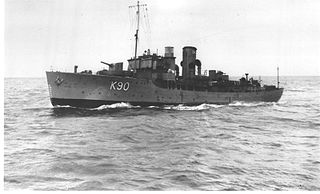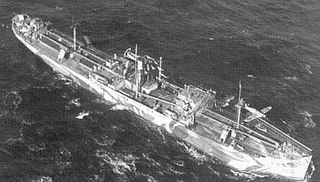SS Empire Shelter was a convoy rescue ship built for the Royal Navy during World War II, originally laid down as the Castle-class corvette HMS Barnard Castle. Completed a month before the end of the war in May 1945, she made a few short voyages before she was reduced to reserve. The ship later served as a barracks ship and then as a troopship before she was sold for scrap in 1955.

SS Empire Peacemaker was a British convoy rescue ship that served at the end of World War II, originally laid down as the corvette HMS Scarborough Castle. Post-war she served as an Army transport ship before being scrapped in 1955.

HMS Hurst Castle (K416) was one of 44 Castle-class corvettes built for the Royal Navy during World War II. Completed in June 1944, she began escorting convoys in August and was sunk by a German U-boat the following month.

HMS Activity was an escort carrier that served with the Royal Navy of the United Kingdom during the Second World War. After the war, she was sold into merchant service as the MV Breconshire, serving for over 20 years until scrapped in 1967.

HMS Gentian was a Royal Navy Flower-class corvette that served in the Battle of the Atlantic during World War II.
Empire Almond was a 6,860 gross register tons (GRT) cargo ship that was built in 1941. She was renamed Marquita in 1946, Marsland in 1951, Huta Zgoda in 1960 and MP-Zozie-12 in 1969. She was scrapped in 1978.
USS Westport (ID-3548) was a United States Navy cargo ship in commission from 1918 to 1919.
SS Empire Comfort was a 1,333 GRT convoy rescue ship which was launched in 1944 as HMS York Castle a Castle-class corvette, but was renamed Empire Castle and converted for merchant service before completion by Ferguson Brothers Ltd., Port Glasgow as yard number 372. She was launched on 20 September 1944. The ship was 252 feet (76.81 m) long, with a beam of 36 feet (10.97 m) and a draught of 13 feet 6 inches (4.11 m).
Philips Wouwerman was a 7,091 GRT cargo ship that was built in 1942 as Empire Courage by Barclay, Curle & Co Ltd, Glasgow, United Kingdom. She was built for the Ministry of War Transport. in 1943, she was transferred to the Dutch Government and renamed Philips Wouwerman. In 1947, she was sold into merchant service and renamed Ceram. A further sale in 1953 saw her renamed Amsteltoren and then Amstelbrug. In 1959, she was sold to Greece and renamed Armathia. A further sale in 1965 saw her renamed Calliman. She served until scrapped in 1968.

Empire Darwin was a British 6,765 GRT CAM ship built in 1941 by William Gray & Co. Ltd., West Hartlepool, United Kingdom for the Ministry of War Transport (MoWT). Her Hawker Sea Hurricane was involved in the last action by an aircraft flown off a CAM ship, shooting down a Focke-Wulf Fw 200 Condor on 28 July 1943.
Stakesby was a 4,026 GRT cargo ship that was built in 1930 by William Pickersgill & Sons Ltd, Sunderland, Co Durham, United Kingdom. She was torpedoed by U-124 in 1940 and later sank. Raised in 1943, she was repaired, passed to the Ministry of War Transport (MoWT) and renamed Empire Derwent. She was sold into merchant service in 1946 and renamed Swan Point, serving until she was wrecked in 1949.
Habib Marikar was a 7,067 GRT cargo ship that was built in 1943 by Short Brothers Ltd, Sunderland, Co Durham as Empire Duchess for the Ministry of War Transport (MoWT). She was sold into merchant service in 1949 and renamed Braemar Castle. A further sale in 1950 saw her renamed King James.
Verna Paulin was a 7,046 GRT cargo ship that was built in 1942 as Empire Envoy by Short Brothers Ltd, Sunderland, Co Durham, United Kingdom for the Ministry of War Transport (MoWT). She was sold into merchant service in 1946 and renamed Cheltenham. A further sale in 1952 saw her renamed La Orilla. A sale to a Swedish company in 1955 saw her renamed Stallberg. In 1958, she was sold to a Finnish company and renamed Verna Paulin. She served until 1969, when she was scrapped.
Pengreep was a 8,806 GRT cargo ship that was built in 1914 by Irvine's Shipbuilding and Drydock Co Ltd, West Hartlepool, Co Durham, United Kingdom for a British company. She was requisitioned by the Admiralty on completion and returned to her owners in 1920. She was seized in June 1940 by Vichy French forces and renamed Ste Jacqueline. In 1942, she was seized by British forces, being renamed Pengreep in 1943. She was passed to the Ministry of War Transport (MoWT) later that year and renamed Empire Fal. In July 1945, she was scuttled with a cargo of gas bombs.

HMS Watchman was a W-class destroyer of the British Royal Navy that saw service in the final months of World War I, in the Russian Civil War, and in World War II.
Empire Flame was a 7,069 GRT CAM ship that was built in 1941 by Cammell Laird & Co Ltd, Birkenhead, United Kingdom for the Ministry of War Transport (MoWT). She was sold in 1945 and renamed Dunkery Beacon. A further sale to Finland in 1955 saw her renamed Rissa. Following a sale in 1961, she was renamed Augusta Paulin. She served until 1969 when she was scrapped.
Jolee was a 5,500-gross register ton (GRT) Design 1022 cargo ship that was built in 1920 by American International Shipbuilding, Hog Island, Philadelphia, Pennsylvania, United States for the United States Shipping Board (USSB). Launched as Cardington, She was completed as Jolee. She was sold in 1933 to Lykes Brothers - Ripley Steamship Co Inc. She was purchased by the Ministry of War Transport (MoWT) in 1941 and renamed Empire Flamingo. She served until June 1944 when she was sunk as a blockship at Juno Beach.
Graigaur was a 7,047 GRT cargo ship that was built in 1941 by Swan, Hunter & Wigham Richardson Ltd, Newcastle upon Tyne, Northumberland, United Kingdom, as the CAM ship Empire Foam for the Ministry of War Transport (MoWT). She was sold in 1946 to Graigaur Shipping Co Ltd and renamed Graigaur. She was sold in 1957 to Marinos & Frangos Ltd and renamed Maltezana. She was sold to the Great Southern Steamship Co Ltd., Hong Kong in 1958 and renamed Johore Bahru, serving until she was scrapped in 1963.
Clan Allan was a 7,043 GRT cargo ship that was built in 1942 as Empire Forest by John Readhead & Sons Ltd, South Shields, County Durham, United Kingdom for the Ministry of War Transport (MoWT). She was sold to Clan Line in 1946 and renamed Clan Allan. Sold in 1958 to Bullard, King & Co Ltd and renamed Umtali, she was sold back to Clan Line the following year and renamed Clan Allan. She was sold to Mullion & Co Ltd, Hong Kong in 1961 and renamed Ardsirod, serving until 1966 when she was scrapped.

Empire Lifeguard (K443) was a convoy rescue ship of the Second World War. Initially built as HMS Maiden Castle - one of 44 Castle-class corvette built for the Royal Navy - she was completed in 1944 as a convoy rescue ship to pick up survivors from attacks on the convoys. Operated for the Ministry of War Transport (MoWT) she served in this role with convoys during the war. Post war she was operated as a transport in the Mediterranean. She was damaged by a terrorist attack and sunk in 1947 but repaired and ultimately sold for scrap in 1955.







